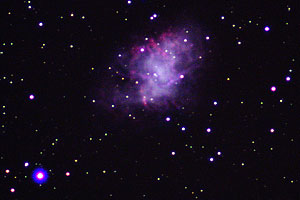 The Crab Nebula as seen through Chabot Space & Science Center’s 8-inch refracting telescope, Leah. Image: Conrad Jung, Chabot Space & Science CenterWhen asked what got me interested in astronomy, the stock answer I offer is my childhood experience going to Chabot Observatory and looking through the telescopes—and I'm sure that had a great deal to do with it. But, if I want to give an even shorter answer, I just say, "Crab Nebula!" and walk away….
The Crab Nebula as seen through Chabot Space & Science Center’s 8-inch refracting telescope, Leah. Image: Conrad Jung, Chabot Space & Science CenterWhen asked what got me interested in astronomy, the stock answer I offer is my childhood experience going to Chabot Observatory and looking through the telescopes—and I'm sure that had a great deal to do with it. But, if I want to give an even shorter answer, I just say, "Crab Nebula!" and walk away….
What's the Crab Nebula? Astronomy enthusiasts are very familiar with this celestial object, or at least become so very quickly after entering the world of space. It's a supernova remnant—a torn and tortured cloud of gases expanding outward into space, the aftermath of a supernova explosion that happened almost a thousand years ago in the constellation Taurus. In fact, as I write this blog, the age of the Crab Nebula is exactly 955 years and 40 days.
How do we know with such precision when this former star went supernova? The answer, as always in science, is careful observation! The explosion of the star was witnessed by Chinese and Japanese astronomers—and possibly sky watchers of the American Southwest—who carefully observed and recorded the event. The explosion took place on July 4th, 1054 CE.
Seven hundred years later, a century after the invention of the telescope, the Crab Nebula was discovered in the same spot—first in 1731 by John Bevis, then again by Charles Messier in 1758 (August 28, in fact—the date of this blog posting!). Messier ran across it while searching for Halley's Comet, and at first mistook it for a comet. This was the reason that he began compiling his famous Messier catalog of "fuzzy" objects: a wall of mug shots of unusual suspects that resembled, but were imposters of, comets. He began his catalog with Messier 1 (M1), the Crab Nebula.
Messier 1 got its nickname of the Crab from a drawing made by observer Lord Rosse in 1844.
Today, the Crab Nebula is an expanding cloud of gas and some dust spanning 10 light years, or 60 trillion miles. The cloud is still expanding at a speed of about 1,800 kilometers per second—a speed that would get you to the Moon in just under 4 minutes! At its center is the collapsed remnant of the dead star's core, which has become the incredibly small and dense object known as a neutron star.
